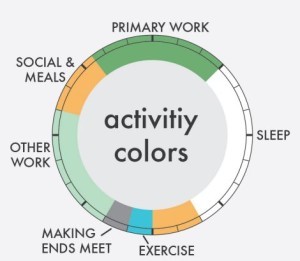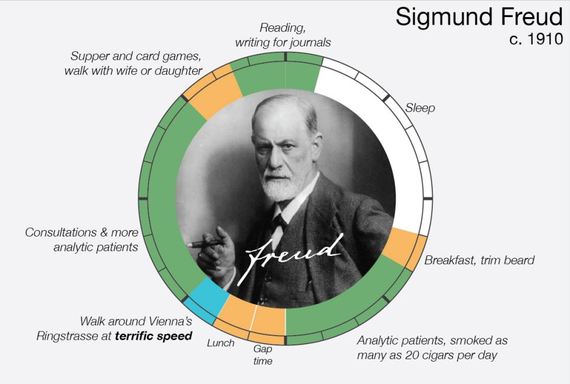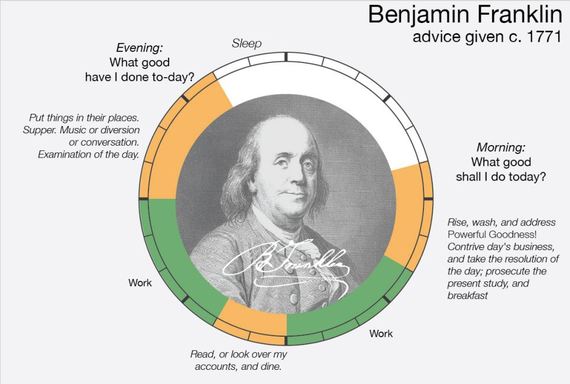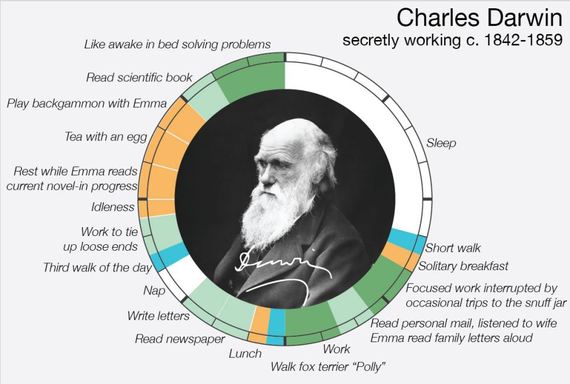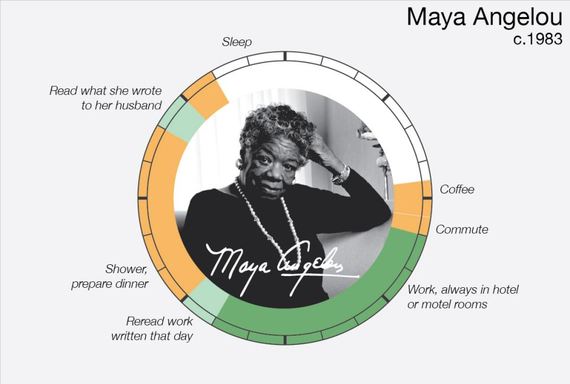When you think about strategies that make your workforce productive and innovative, how granular have you gotten? We often benchmark companies to learn best practices, but in people management, we rarely benchmark our practices by looking at high-performing individuals. Recently, a few different designers have taken infographics to a new level by reviewing how geniuses historically have spent their day.
From the Daily Mail:
Using Mason Currey's book Daily Rituals: How Artists Work -- which draws on diaries and letters from the thinkers themselves -- designer RJ Andrews has mapped out the comings and goings of some of history's most important figures, right down to the hour.
Each circle represents the 24 hours in a day with the topmost point representing midnight and the bottom point representing noon. The colors represent different activities.
So what can we learn from these geniuses with regards to our organizations?
Walking
Whether scientists, musicians, or writers, the majority of geniuses spent some amount of their day walking. Charles Darwin even took three walks per day, spread evenly throughout.
Some of the top Fortune 500 companies took a note from these geniuses and create environments that encourage taking breaks outside, to help rejuvenate employees but also to encourage connection.
Consider the environment DreamWorks Animation has created, with an extensive campus of outdoor walkways, fountains, and courtyards. Not so coincidentally, they also happen to have a 97 percent retention rate and a revenue of near $150 million. "Many times true innovation, true original ideas, don't happen in a conference room or in someone's office," says Dan Satterthwaite, head of human resources at DreamWorks. "They happen in hallways, they happen outside. It's the function of people running into each other that was really thought through in the layout of the campus."
The risk with the next generation is if we don't create this kind of environment, we will get into a habit of staying in front of our screens. When it comes down to it, we won't know what to do or how to spend our time if we didn't have virtual connection.
Reading
Geniuses spent a significant block of time every day staying informed, but also thinking deeply on what they've read.
Today when we consider the amount of information we have to process, no longer only in print form, we have to consider a different strategy to stay informed and comprehend the information. Tools like Clearly by Evernote can be very helpful. Clearly is a browser add-in that in one click removes the ads and distractions on webpages and shows you only the article you intend to read.
Focused Time
The majority of geniuses spend long blocks of time in an environment where they can focus on ideation, creation, meditation, and sometimes connecting/interviewing with people.
Open layouts may be the trend currently, but, as many Millennials will tell you, having a choice between collaboration areas and focused work areas is really the best way to be productive.
The Journal of Environmental Psychology reports, "Open-plan layouts are widely acknowledged to be more disruptive due to uncontrollable noise and loss of privacy."
Consider today the amount of physical and digital noise we all must filter through to focus and concentrate. Reflection rooms, meditations rooms, and quiet workspaces are a must to help employees disconnect, reflect and come back ready to innovate and problem solve.
Another great culture building idea is Benjamin Franklin's habit of waking up with "What good shall I do today?" and ending with "What good have I done today?" Creating a culture where groups share what their goals are at the beginning of the day and what they accomplished by the end of the day can be a really great way to boost productivity and recognition at the same time. Consider adding this to your internal social networking strategy.
What would your map look like? I wonder how many of our maps would be based around unproductive screen time.
What we can learn from geniuses ultimately is that getting inspiration comes from activity, not the inactive, digital comas we tend to drown in today.
What can you do to empower your organization to spend their time and ultimately, make contributions like history's biggest thinkers have?
All images used with permission courtesy of RJ Andrews. His work can be found here infowetrust.com. All data can be sourced from Mason Currey's book Daily Rituals: How Artists Work.

